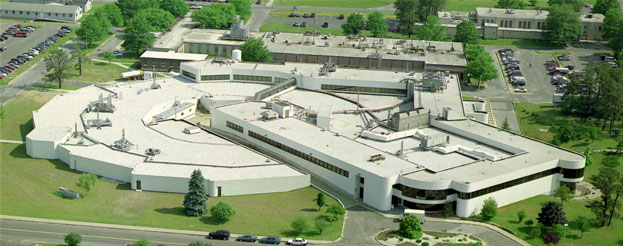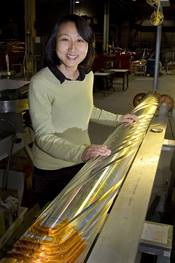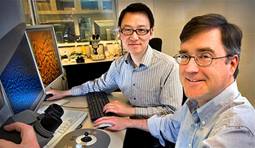Brookhaven National Laboratory
This third installment of the series on the Department of Energy's (DOE's) National Labs focuses on Brookhaven: Its people and their passion for discovery.

Located on a 5,300 acre campus in Upton New York, Brookhaven National Lab was established in 1947. It is currently led by Director Samuel Aronson, a physicist who has been with the lab for more than three decades. Some 3,000 scientists, engineers, technicians and support staff are employed at Brookhaven. And more than 5,000 researchers come there each year to use its unique facilities.
 Photo courtesy of Brookhaven National Laboratory
Photo courtesy of Brookhaven National Laboratory
Brookhaven accelerator physicist Mei Bai with a Siberian snake magnet. The magnets' corkscrew-like design causes the direction of the magnetic field to spiral along the direction of a particle beam running through it. As the beam moves through snakes, the magnetic field flips the polarization, or direction of spin.
For instance, Brookhaven operates the Relativistic Heavy Ion Collider, which smashes heavy ions (charged atoms) together at extremely high speeds. Those collisions briefly create temperatures and pressures more extreme than found at the hearts of stars, conditions akin to what the universe was like in its first moments some 13+ billion years ago. That's what scientists are after, since understanding how matter behaved then can help us better understand it today, and why our universe became this way.
Brookhaven is also home to the National Synchrotron Light Source, which is used to determine the structure of important materials—including biological molecules like proteins and superconductors for energy applications—down to the level of individual atoms. Determining their structure can give insight into what they do, and even how to improve the things they do, such as in the case of building more efficient batteries.
The Center for Functional Nanomaterials is also at Brookhaven. It provides researchers the ability to make and study materials on tiny scales, down to billionths of a meter (for comparison, a human hair is approximately 100,000 nanometers wide). And research at the Center may lead the way to designing new materials with novel properties that help us meet our energy needs.
Given Brookhaven's outstanding scientific facilities, it's little wonder that some seven Nobel Prizes have been awarded for work done, at least in part, using its exceptional tools: http://www.bnl.gov/bnlweb/history/nobel/. The first winners were T. D. Lee and C. N. Yang, who were awarded the 1957 Nobel Prize in Physics for discovering that one of nature's supposedly absolute laws (the law of parity conservation), had been violated. Four other Nobel Prizes in Physics followed: 1976, 1980, 1988 and 2002. In 2003, Roderick MacKinnon broke that noble tradition in physics by sharing a Nobel Prize in Chemistry for his work in explaining how nerve impulses are generated. And in 2009, Venkatraman Ramakrishnan and Thomas A. Steitz shared another Nobel Prize in Chemistry, for revealing the inner workings of an essential cellular machine known as a ribosome.
 Photo courtesy of Brookhaven National Laboratory
Photo courtesy of Brookhaven National Laboratory
Scientists Doug Su and Eric Stach analyze samples of activated graphene, a material (developed by University of Texas-Austin scientists) with high energy storage capacity and unlimited recharge, at the Center for Functional Nanomaterials.
In addition to their profound discoveries, Brookhaven's scientists have also created life-changing innovations. They produced synthetic insulin, pioneered the use of L-dopa for treating Parkinson's disease and developed technetium-99m, a substance used to diagnose heart disease and other illnesses in more than 11 million Americans each year. Brookhaven's researchers have also created advanced coatings for corrosion prevention, invented magnetically levitated (Maglev) trains and advanced the designs of computer chips.
Today, that dual work of discovery and innovation continues at Brookhaven. Its scientists are searching for fundamental answers about the universe and the stuff that makes it up. Its engineers are applying their skills to developing new materials and addressing critical energy problems. Together they're opening the way to understanding high-temperature superconductors, building more efficient fuel cells and even targeting tuberculosis, all three of which were among Brookhaven's Top 5 Scientific Discoveries for 2010.
That's Brookhaven: People with an impact, and a passion for discovery.
For more information on Brookhaven, please go to http://www.bnl.gov/world/. And for more information on the DOE Office of Science, please go to: http://www.science.energy.gov/.
Charles Rousseaux is a Senior Writer in the Office of Science


